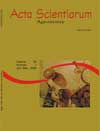<strong>Physical and sensory characterization of coffee produced in the topoclimatic conditions at Jesuítas, Paraná State (Brazil)</strong> - DOI: 10.4025/actasciagron.v30i3.3513
Keywords:
Coffea arabica, cup quality, acidity
Abstract
Climatic variations influence formation and maturation of coffee grains by altering their intrinsic characteristics, which can allow for several types of coffee qualities, including the potential for production of special coffee. This study was carried out to verify the effect of environmental conditions and crop cultivation on chemical composition and their consequences in cup quality of coffees from region of Jesuítas, Paraná State. During the same crop season this study was accomplished (2002-2003), cup quality was evaluated among the producers in several coffee-growing municipalities in Paraná State. It was observed that 86% of samples were classified simply as “soft” (smooth flavor) or “hard” (bolder flavor), and 14% were classified as rioysh/rio (strong unpleasant taste). The results concluded that the practices adopted by producers, who have collaborated with the study, reflected positively on the final cup quality, when compared to the overall quality results in the State. The climatic conditions and practices of crop management and harvest in the Jesuitas region made for bolder coffee with low acidity, comparable to high quality coffees produced in Brazil and abroad.Downloads
Download data is not yet available.
Published
2008-05-27
How to Cite
Dal Molin, R. N., Andreotti, M., Reis, A. R. dos, Furlani Junior, E., Braga, G. C., & Scholz, M. B. dos S. (2008). <strong>Physical and sensory characterization of coffee produced in the topoclimatic conditions at Jesuítas, Paraná State (Brazil)</strong> - DOI: 10.4025/actasciagron.v30i3.3513. Acta Scientiarum. Agronomy, 30(3), 353-358. https://doi.org/10.4025/actasciagron.v30i3.3513
Issue
Section
Crop Production
DECLARATION OF ORIGINALITY AND COPYRIGHTS
I Declare that current article is original and has not been submitted for publication, in part or in whole, to any other national or international journal.
The copyrights belong exclusively to the authors. Published content is licensed under Creative Commons Attribution 4.0 (CC BY 4.0) guidelines, which allows sharing (copy and distribution of the material in any medium or format) and adaptation (remix, transform, and build upon the material) for any purpose, even commercially, under the terms of attribution.
2.0
2019CiteScore
60th percentile
Powered by 

2.0
2019CiteScore
60th percentile
Powered by 



















































